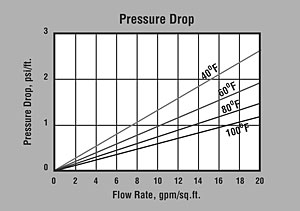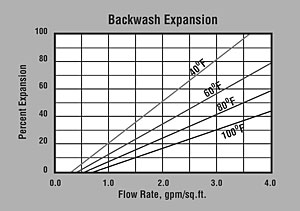| APPLICATIONS: |
| • |
Dealkalization |
| • |
Deionization |
| • |
Chemical Processing |
|
| |
| |
 |
| |
| PRESSURE DROP — The graph above shows the expected pressure loss per foot of bed depth as a function of flow rate at various temperatures. |
| |
| |
 |
| |
| BACKWASH — After each cycle the resin bed should be backwashed at a rate that expands the bed 50 to 75 percent. This will remove any foreign matter and reclassify the bed. The graph above shows the expansion characteristics of ProSelect™ General Purpose in the chloride form. |
| |
| |
POUNDS
NaOH
per cu.ft. |
CAPACITY
Kilograins
per cu.ft. |
| 4 |
21.0 |
| 6 |
22.5 |
| 8 |
23.5 |
| 10 |
24.4 |
| 12 |
24.9 |
|
|
The Operating Capacity of ProSelect™ General Purpose Anion Resin for acid removal at various regeneration levels when treating an influent of 500 ppm of HCl, as CaCO3. |
| |
|
|
| |
|
|
POUNDS
NaOH
per cu.ft. |
CAPACITY
Kilograins
per cu.ft. |
| 4 |
19.5 |
| 6 |
20.7 |
| 8 |
21.6 |
| 10 |
22.2 |
| 12 |
22.6 |
|
|
The Salt Splitting Capacity of ProSelect™ General Purpose Anion Resin at various regeneration levels, based on an influent water containing 500 ppm of NaCl, as CaCO3. |
|
| |
| |
| ProSelect™ is a trademark of Safe Water Technologies, Inc. |
|
|
| |
Features: |
|
| |
• |
Conforms to paragraph 21 CFR173.25 of the Food Additives Regulations of the FDA |
|
| |
• |
Uniform particle size, low pressure drop |
|
| |
• |
Superior physical stability |
|
| |
• |
Organic fouling resistance, high operating capacity |
|
| |
• |
Certified to NSF/ANSI Standard 61 |
|
|
| |
| PHYSICAL PROPERTIES |
| Part Number |
ER20004 |
| Polymer Structure |
Styrene crosslinked with DVB |
| Functional Group |
R-N-(CH3)2 C2H5OH+ X- |
| Ionic Form (as shipped) |
Chloride or Hydroxide |
| Physical Form |
Tough spherical beads |
Screen Size Distribution
+ 16 mesh (US Std.)
– 50 mesh (US Std.) |
2% maximum
1% maximum |
| pH Range |
0 to 14 |
| Sphericity |
93% minimum |
| Uniformity Coefficient |
1.7 approx. |
Water Retention
Chloride Form
Hydroxide Form |
37 to 45%
43 to 50% |
| Solubility |
Insoluble |
Approx. Ship. Wt.
Chloride Form
Hydroxide Form |
44 lb/cu.ft.
41 lb/cu.ft. |
| Swelling Cl- to OH- Form |
10 to 15% |
Total Capacity
Chloride Form
Hydroxide Form |
1.45 meq/mL min.
1.30 meq/mL min. |
|
| |
| SUGGESTED OPERATING CONDITIONS |
Maximum Temperature
Chloride Form
Hydroxide Form |
170°F (77°C)
95°F (35°C) |
| Minimum Bed Depth |
24 inches |
Backwash Rate
50% Bed Exp. @ 60°F |
(See graph left)
2.7 gpm/sq.ft. |
| Regenerant Concentration * |
2 to 6% |
| Regenerant Flow Rate |
0.25 to 1.0 gpm/cu.ft. |
| Regenerant Contact Time |
60 minutes minimum |
| Regenerant Level |
4 to 10 lb/cu.ft. |
| Displacement Rinse Rate |
0.25 to 1.0 gpm/cu.ft. |
| Displacement Rinse Volume |
10 to 15 gal/cu.ft. |
| Fast Rinse Rate |
2 to 4 gpm/cu.ft. |
| Fast Rinse Volume |
35 to 60 gal/cu.ft. |
| Service Flow Rate |
2 to 4 gpm/cu.ft. |
| Pressure Drop |
(See graph left) |
|
| |
| |
|
* CAUTION: DO NOT MIX ION EXCHANGE RESINS WITH STRONG OXIDIZING AGENTS. Nitric acid and other strong oxidizing agents can cause explosive reactions when mixed with organic materials such as ion exchange resins.
|
| |
ADDITIONAL INFORMATION:
SWT Ion Exchange Resin Guide |
| |
| |
|
This information has been gathered from standard materials and or test data that is believed to be accurate and reliable. Nothing herein shall be determined to be a warranty or representation expressed or implied with respect to the use of such information or the use of the goods described for any particular purpose alone or in combination with other goods or processes, or that their use does not conflict with existing patent rights. No license is granted to practice any patented invention. It is solely for your consideration, investigation and verification.
|
|


